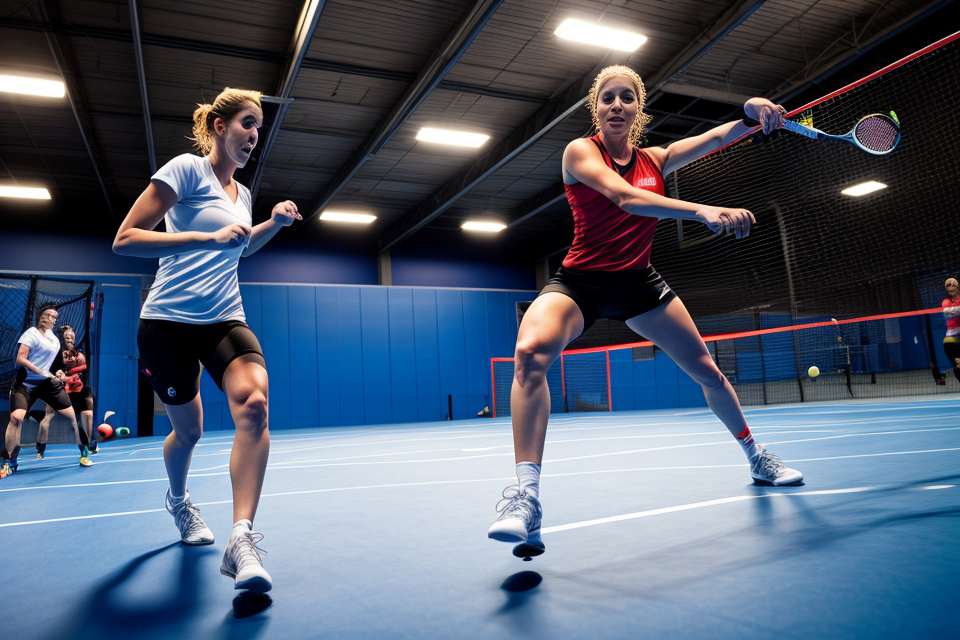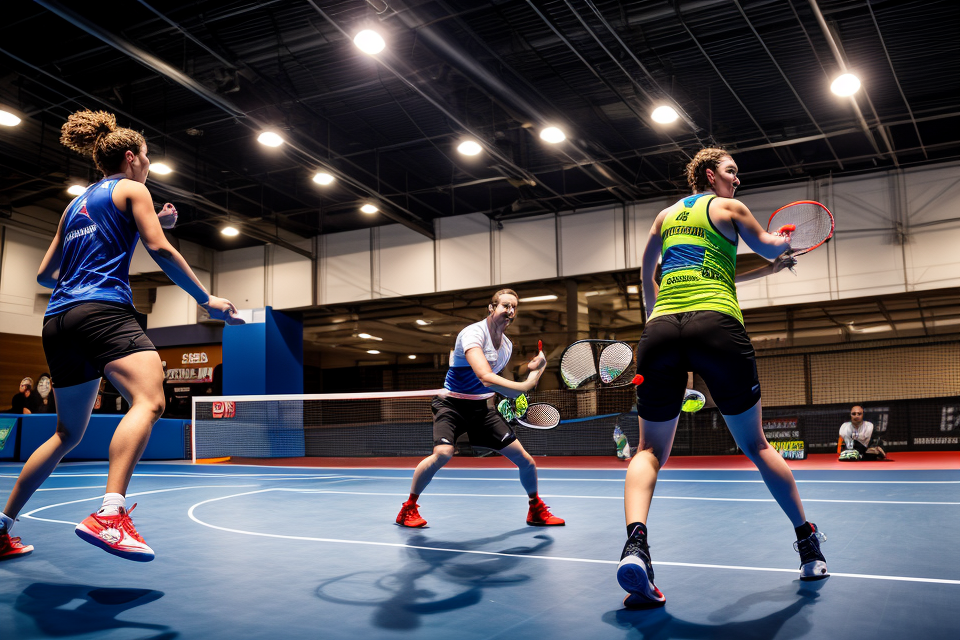Squash is a physically demanding sport that requires players to have a high level of cardiovascular endurance. Cardiovascular endurance is the ability of the heart and lungs to supply oxygen to the muscles during sustained physical activity. In squash, cardiovascular endurance is crucial because it allows players to maintain a high level of intensity and play for extended periods without getting tired. In this article, we will explore the importance of cardiovascular endurance in squash and how it can affect your performance on the court. We will also provide tips on how to improve your cardiovascular endurance and enhance your squash game.
What is Cardiovascular Endurance?
Definition and Explanation
Cardiovascular endurance is the ability of the heart, lungs, and muscles to sustain physical activity for an extended period of time. It is the ability of the cardiovascular system to deliver oxygen and nutrients to the working muscles, and to remove metabolic waste products. This is a crucial aspect of physical fitness that is often overlooked by many people who focus solely on strength training or endurance sports.
Cardiovascular endurance is important in squash because it allows you to maintain a high level of physical activity for the duration of the game. It is what enables you to move around the court quickly and efficiently, to sustain a fast pace, and to recover quickly between points. Without a good level of cardiovascular endurance, you will quickly become fatigued and your performance will suffer.
To improve your cardiovascular endurance, you need to engage in regular aerobic exercise such as running, cycling, or swimming. These activities will help to improve the efficiency of your cardiovascular system, increase your lung capacity, and strengthen your heart muscle. The more you train, the more your cardiovascular endurance will improve, and the better you will perform on the squash court.
It is important to note that cardiovascular endurance is not the only factor that affects your performance in squash. Other factors such as muscle strength, flexibility, and mental toughness also play a crucial role. However, having a good level of cardiovascular endurance will give you a significant advantage over your opponents and help you to perform at your best.
Importance in Squash
Cardiovascular endurance is the ability of the heart, lungs, and blood vessels to provide oxygen and nutrients to the muscles during sustained physical activity. It is a critical component of fitness for squash players, as the sport requires constant movement, rapid changes of direction, and bursts of intense effort.
Here are some reasons why cardiovascular endurance is so important in squash:
- Energy Production: Squash is a high-intensity sport that requires the body to produce energy rapidly. Cardiovascular endurance helps the body to efficiently deliver oxygen and nutrients to the muscles, which in turn allows for more efficient energy production.
- Stamina: Squash matches can last up to 90 minutes or more, and players need to maintain a high level of physical activity throughout the match. Cardiovascular endurance helps players to maintain their energy levels and avoid fatigue, which can impact their performance.
- Agility and Speed: Squash requires quick movements and changes of direction, and players need to be fast and agile to be successful. Cardiovascular endurance helps to improve cardiovascular health, which in turn can enhance speed and agility on the court.
- Recovery: Squash can be a physically demanding sport, and players need to be able to recover quickly between points and games. Cardiovascular endurance helps the body to recover more quickly, which can help players to maintain their intensity and focus throughout the match.
In summary, cardiovascular endurance is essential for squash players, as it helps to improve energy production, stamina, agility, speed, and recovery. By developing their cardiovascular endurance, players can improve their overall fitness and enhance their performance on the squash court.
Benefits of Cardiovascular Endurance in Squash
Improved Stamina and Endurance
Cardiovascular endurance is a critical component of squash performance, as it allows players to maintain a high level of activity for extended periods. Improved stamina and endurance are directly linked to cardiovascular endurance, and these benefits can significantly impact a player’s ability to perform at their best during a match.
One of the primary benefits of improved cardiovascular endurance is the ability to maintain a consistent pace throughout the match. Players with higher levels of cardiovascular endurance can sustain their energy output for longer periods, reducing the risk of fatigue and exhaustion. This can help players to maintain a high level of intensity and focus throughout the match, which can be crucial in winning crucial points or making strategic decisions.
Additionally, improved stamina and endurance can also help players to recover more quickly between points and games. This can be particularly beneficial in high-intensity matches, where players may need to recover quickly between points to maintain their performance levels. Improved recovery can also help to reduce the risk of injury, as players can avoid pushing themselves too hard and risking overexertion.
Finally, improved cardiovascular endurance can also help players to perform at their best in the later stages of a match. As the match progresses, fatigue can become a significant factor, and players may struggle to maintain their energy levels and focus. However, players with higher levels of cardiovascular endurance may be better equipped to maintain their performance levels, even as the match wears on.
Overall, improved stamina and endurance are critical benefits of cardiovascular endurance in squash. By improving their cardiovascular endurance, players can maintain a high level of intensity and focus throughout the match, recover more quickly between points and games, and perform at their best in the later stages of a match.
Enhanced Physical and Mental Capacity
Cardiovascular endurance is a critical aspect of physical fitness that can significantly impact a squash player’s performance. By developing and maintaining high levels of cardiovascular endurance, players can improve their physical and mental capacity, which translates to better performance on the court.
Physical Capacity
Physical capacity refers to the body’s ability to perform physical tasks. In squash, physical capacity is essential as it enables players to move around the court quickly, change direction abruptly, and maintain high intensity for extended periods. Cardiovascular endurance plays a significant role in improving physical capacity. By training the heart and lungs to work more efficiently, the body can deliver more oxygen and nutrients to the muscles, which in turn improves muscle function and endurance. This means that players with higher levels of cardiovascular endurance can sustain high-intensity movements for longer periods, which can give them an advantage in squash matches.
Mental Capacity
Apart from physical capacity, cardiovascular endurance also affects mental capacity. Squash is a mentally demanding sport that requires players to stay focused, make quick decisions, and maintain concentration throughout the match. Cardiovascular endurance can improve mental capacity by increasing blood flow to the brain, which enhances cognitive function and decision-making ability. Additionally, by reducing the perception of effort, cardiovascular endurance can help players stay motivated and focused throughout the match, which can translate to better performance.
In conclusion, developing and maintaining high levels of cardiovascular endurance is crucial for squash players looking to improve their performance. By enhancing physical and mental capacity, players can move more efficiently around the court, maintain high-intensity movements for longer periods, and make better decisions under pressure.
Reduced Risk of Injury
Cardiovascular endurance, or the ability of the heart and lungs to provide oxygen to the muscles during physical activity, is a crucial aspect of athletic performance. In squash, a sport that requires rapid movement and change of direction, cardiovascular endurance can greatly impact a player’s ability to perform at their best.
One of the primary benefits of having high cardiovascular endurance is a reduced risk of injury. This is because cardiovascular endurance helps to improve the overall health and efficiency of the heart and circulatory system. A stronger heart and circulatory system can pump blood more efficiently, which means that the muscles receive more oxygen and nutrients, and waste products are removed more quickly. This, in turn, can help to reduce the risk of injuries such as muscle strains, cramps, and tears.
Additionally, having high cardiovascular endurance can also help to reduce the risk of overuse injuries, which are often caused by repetitive motions or sudden changes in direction. By improving the efficiency of the heart and circulatory system, cardiovascular endurance can help to reduce the stress placed on the joints and muscles, which can help to prevent overuse injuries.
Overall, having high cardiovascular endurance can be a key factor in reducing the risk of injury in squash. By improving the health and efficiency of the heart and circulatory system, players can improve their ability to perform at their best, while also reducing the risk of injuries that can impact their performance.
Improving Cardiovascular Endurance for Squash
Training Programs and Exercises
To improve cardiovascular endurance for squash, it is important to incorporate specific training programs and exercises that target the energy systems used during the sport. This includes both aerobic and anaerobic exercises that increase heart rate and build endurance.
One effective training program for improving cardiovascular endurance in squash is interval training. This involves alternating between periods of high-intensity exercise and periods of rest or low-intensity exercise. For example, a player might perform 4-6 sets of 30 seconds of squash-specific drills at maximum effort, followed by 30 seconds of rest. This type of training can help improve both aerobic and anaerobic capacity, as well as build mental toughness and improve overall fitness.
Another important aspect of improving cardiovascular endurance for squash is incorporating resistance training into the training program. This can include exercises such as weightlifting, resistance bands, or bodyweight exercises that target the muscles used in squash, including the legs, core, and upper body. Resistance training can help improve muscular endurance, increase power and strength, and reduce the risk of injury.
In addition to interval training and resistance training, it is also important to incorporate general cardiovascular exercises such as running, cycling, or swimming into the training program. These exercises can help improve overall cardiovascular endurance and endurance in specific energy systems used during squash.
Overall, a well-rounded training program that includes a combination of interval training, resistance training, and general cardiovascular exercises can help improve cardiovascular endurance and overall performance in squash. It is important to consult with a qualified trainer or coach to develop a personalized training program that meets individual needs and goals.
Nutrition and Hydration
Cardiovascular endurance is crucial for success in squash, as it enables players to maintain high levels of intensity and sustain their performance over the course of a match. To improve cardiovascular endurance, nutrition and hydration play a critical role. Here are some tips to help you optimize your diet and stay hydrated during your squash training and matches.
Nutrition
- Eat a balanced diet: Focus on consuming nutrient-dense foods such as fruits, vegetables, whole grains, lean proteins, and healthy fats. These foods provide the necessary energy and nutrients to support your training and improve your overall health.
- Include carbohydrates: Carbohydrates are an essential source of energy for physical activity. Incorporate complex carbohydrates like whole grains, beans, and starchy vegetables into your meals to help fuel your workouts and matches.
- Hydrate before, during, and after exercise: Proper hydration is vital for optimal performance and avoiding dehydration. Drink plenty of water throughout the day, and consume electrolyte-rich beverages like sports drinks or coconut water during and after exercise to replenish lost fluids and electrolytes.
Hydration
- Stay hydrated before and during matches: Drink water or sports drinks in the hours leading up to your match to ensure you’re well-hydrated. Aim to consume 5-7 milliliters of water per kilogram of body weight two to three hours before the match, and continue sipping water during the match at regular intervals.
- Monitor your urine color: Aim to urinate a pale yellow color before and during exercise to ensure adequate hydration. If your urine is dark or strong in color, it may indicate dehydration, and you should increase your fluid intake.
- Avoid dehydrating beverages: Limit your intake of caffeinated, alcoholic, or sugary beverages, as they can contribute to dehydration and negatively impact your performance.
By focusing on proper nutrition and hydration, you can enhance your cardiovascular endurance and maintain peak performance during your squash matches. Remember to tailor your diet to your individual needs and consult with a healthcare professional or registered dietitian for personalized advice.
Recovery and Rest
- The Importance of Recovery: Recovery and rest are crucial components of improving cardiovascular endurance for squash. The body needs time to repair and rebuild muscle tissue, reduce inflammation, and recover from training.
- Active Recovery: Active recovery, such as light exercise or stretching, can help improve circulation, reduce muscle soreness, and prevent injury. This type of recovery is especially beneficial for squash players who have had intense training sessions.
- Passive Recovery: Passive recovery, such as rest and sleep, is essential for muscle repair and growth. The body repairs and rebuilds muscle tissue during periods of rest, allowing for increased strength and endurance.
- Sleep: Sleep is particularly important for athletes, as it allows for muscle repair and growth. Adequate sleep also helps improve concentration and focus, which are essential for performing well in squash.
- Nutrition: Proper nutrition is also crucial for recovery and rest. Eating a balanced diet that includes a variety of nutrients, such as protein, carbohydrates, and healthy fats, can help repair and rebuild muscle tissue, reduce inflammation, and improve overall health.
- Hydration: Staying hydrated is also important for recovery and rest. Dehydration can lead to fatigue, headaches, and other negative effects on the body, making it difficult to perform well in squash.
By incorporating recovery and rest into their training regimen, squash players can improve their cardiovascular endurance and overall performance on the court. Whether through active recovery, passive rest, proper nutrition, or adequate hydration, these strategies can help athletes perform at their best and reduce the risk of injury.
Cardiovascular Endurance vs. Other Components of Fitness
Strength and Power
Cardiovascular endurance and strength and power are two key components of fitness that impact a player’s performance in squash. While cardiovascular endurance focuses on the body’s ability to efficiently deliver oxygen and nutrients to working muscles, strength and power refer to the muscular force and explosiveness that allow for powerful shots and quick movements on the court.
While cardiovascular endurance is crucial for sustained performance and preventing fatigue, strength and power are essential for executing powerful shots and rapid changes of direction. Strength and power training can help players develop the muscular force necessary for hitting the ball with greater speed and accuracy, as well as the explosiveness needed for quick movements and sudden changes in direction.
There are various exercises and training methods that can be used to improve strength and power in squash players, including resistance training, plyometrics, and explosive drills. These exercises target different muscle groups, such as the legs, core, and upper body, and can help players develop the muscular strength and power needed to excel on the squash court.
It is important to note that while strength and power are crucial for success in squash, they must be balanced with adequate cardiovascular endurance to prevent fatigue and maintain peak performance throughout a match. Therefore, a well-rounded fitness program that includes both strength and power training and cardiovascular endurance training is essential for optimizing performance in squash.
Flexibility and Mobility
While cardiovascular endurance is a crucial aspect of fitness for squash players, it is not the only factor that contributes to overall performance. Flexibility and mobility are also essential components of physical fitness that can impact a player’s ability to move and perform on the court.
Flexibility refers to the range of motion of a joint or group of joints, while mobility refers to the ability to move a joint through its full range of motion. Both flexibility and mobility are important for squash players because the sport requires quick and dynamic movements in all directions.
Improving flexibility and mobility can help squash players in several ways. For example, greater flexibility in the hips and lower back can help players move more freely and reduce the risk of injury. Additionally, increased mobility in the shoulders and upper back can improve a player’s ability to reach and extend their arms, which is important for hitting accurate shots.
There are several exercises and stretches that can help improve flexibility and mobility for squash players. These may include static stretches, such as hamstring and calf stretches, as well as dynamic stretches, such as leg swings and arm circles. Additionally, incorporating mobility exercises, such as foam rolling and self-myofascial release, can help increase range of motion and reduce muscle tightness.
Overall, while cardiovascular endurance is a critical component of fitness for squash players, it is important to remember that flexibility and mobility are also essential for optimal performance on the court. By incorporating exercises and stretches that target these areas, players can improve their range of motion, reduce the risk of injury, and enhance their overall performance in squash.
Coordination and Agility
In the sport of squash, coordination and agility are essential for success. These physical qualities enable players to move quickly and efficiently around the court, and to react swiftly to changes in the game. While cardiovascular endurance is an important factor that contributes to overall athletic performance, it is not the only determinant of coordination and agility in squash.
There are several other physical and mental factors that contribute to coordination and agility in squash. These include:
- Strength and power: A player’s strength and power can affect their ability to hit the ball with force and accuracy, and to move quickly and powerfully around the court.
- Flexibility and mobility: Squash players need to be able to move their bodies in a variety of directions, and to perform rapid changes of direction. Flexibility and mobility are essential for this, as they allow players to move their limbs and joints through a full range of motion.
- Reaction time and decision-making: In squash, players need to be able to react quickly to changes in the game, and to make split-second decisions about how to play each point. Reaction time and decision-making ability are therefore crucial for success in the sport.
- Mental focus and concentration: Mental focus and concentration are also important for coordination and agility in squash. Players need to be able to maintain their focus and concentration throughout the game, and to stay calm and composed under pressure.
While cardiovascular endurance is an important factor that contributes to overall athletic performance in squash, it is not the only determinant of coordination and agility. Other physical and mental factors, such as strength and power, flexibility and mobility, reaction time and decision-making, and mental focus and concentration, also play a crucial role in the sport.
Recap of Key Points
- Cardiovascular endurance is a key component of fitness that is essential for athletes participating in squash.
- Other components of fitness, such as strength, power, and flexibility, are also important for squash performance, but they are not as crucial as cardiovascular endurance.
- Cardiovascular endurance is defined as the ability of the heart, lungs, and muscles to work together to supply oxygen to the muscles during prolonged exercise.
- Squash is a high-intensity sport that requires repeated bursts of intense physical activity, making cardiovascular endurance particularly important.
- Without adequate cardiovascular endurance, athletes may experience fatigue, shortness of breath, and reduced performance during matches.
- Cardiovascular endurance can be improved through regular aerobic exercise, such as running, cycling, or swimming, as well as through specific training exercises designed to enhance cardiovascular fitness.
- Athletes who prioritize the development of their cardiovascular endurance are more likely to experience improved performance, reduced risk of injury, and better overall health and well-being.
Future Research Directions
Investigating the Relationship Between Cardiovascular Endurance and Muscle Strength
One area of future research could explore the relationship between cardiovascular endurance and muscle strength in squash players. This study could examine whether there is a correlation between cardiovascular endurance and muscle strength, and whether improving one component can lead to improvements in the other.
Examining the Effects of Different Training Methods on Cardiovascular Endurance
Another potential area of research could investigate the effects of different training methods on cardiovascular endurance in squash players. This study could compare the efficacy of various training methods, such as interval training, steady-state cardio, and resistance training, in improving cardiovascular endurance in squash players.
Determining the Optimal Level of Cardiovascular Endurance for Squash Performance
A third potential area of research could determine the optimal level of cardiovascular endurance for squash performance. This study could assess the impact of different levels of cardiovascular endurance on squash performance, and determine the optimal level of cardiovascular endurance for optimal squash performance.
Examining the Effects of Age and Gender on Cardiovascular Endurance in Squash
Finally, a study could be conducted to examine the effects of age and gender on cardiovascular endurance in squash players. This study could investigate whether there are any differences in cardiovascular endurance between male and female squash players, and whether age has an impact on cardiovascular endurance in squash players.
FAQs
1. What is cardiovascular endurance?
Cardiovascular endurance is the ability of the heart, lungs, and circulatory system to deliver oxygen and nutrients to the muscles during sustained physical activity. It is an important aspect of fitness that allows the body to perform physical activities for an extended period of time without fatiguing.
2. Why is cardiovascular endurance important in squash?
Cardiovascular endurance is crucial in squash because it allows players to perform at a high intensity for extended periods of time without becoming fatigued. Squash is a physically demanding sport that requires players to move quickly and change direction rapidly, which makes it challenging for the body. Players who have high levels of cardiovascular endurance can maintain a high level of intensity throughout the match, which can give them an advantage over their opponents.
3. How can I improve my cardiovascular endurance for squash?
There are several ways to improve your cardiovascular endurance for squash, including:
* Engaging in regular cardiovascular exercise such as running, cycling, or swimming
* Incorporating interval training into your workout routine, which involves alternating periods of high-intensity exercise with periods of rest or low-intensity exercise
* Participating in squash-specific drills and exercises that focus on improving cardiovascular endurance, such as sprint drills and interval training on the squash court
* Gradually increasing the intensity and duration of your physical activity over time to avoid injury and allow your body to adapt to the demands of the sport.
4. How does cardiovascular endurance affect my performance in squash?
Cardiovascular endurance has a significant impact on performance in squash. Players with high levels of cardiovascular endurance are able to maintain a high level of intensity throughout the match, which allows them to move quickly and change direction rapidly. They are also able to recover more quickly between points and have more energy to finish the match strong. On the other hand, players with low levels of cardiovascular endurance may struggle to maintain a high level of intensity and may become fatigued quickly, which can affect their performance and lead to errors and losses.
5. How do I know if my cardiovascular endurance is adequate for squash?
There are several ways to assess your cardiovascular endurance, including:
* Conducting a fitness test such as a maximal oxygen consumption (VO2 max) test, which measures the amount of oxygen your body can consume during exercise
* Using a heart rate monitor to track your heart rate during exercise and measure your maximum heart rate
* Monitoring your performance in squash-specific drills and exercises, such as sprint drills and interval training on the squash court, and tracking your progress over time.
Overall, it is important to regularly assess your cardiovascular endurance and make adjustments to your training routine as needed to ensure that you are able to perform at your best on the squash court.










